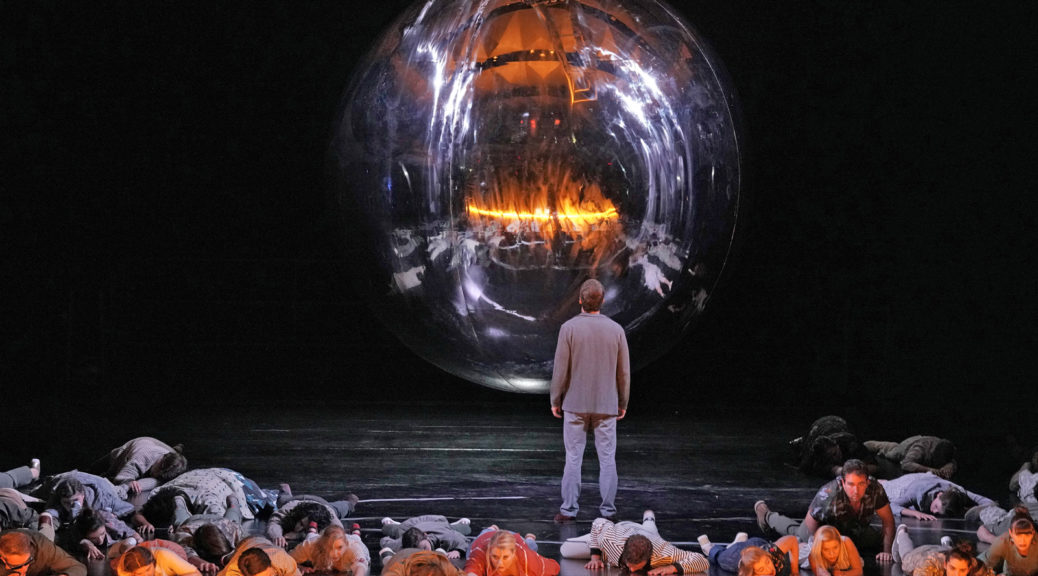
ATOMS, THUNDERSTORMS SHAKING UP OPERA WORLD
SANTA FE, NM—The Santa Fe Opera’s fascination with 21st-century works came to a head with “Doctor Atomic,” which sold out all six performances up to a month ahead, to the wonderment of all. The box office tsunami for the historical opera about creating The Bomb was partly because of the hot John Adams-Peter Sellars creative team, and partly because its development under Robert Oppenheimer occurred right up the road in Los Alamos during World War Two. As one local put it, “It’s all about us.”
The opera caught some of the enigma that was the mercurial physicist Oppenheimer, a brilliant technical researcher with a deep love of poetry, as well as with deep doubts about unleashing the deadliest weapon in world history on civilian populations.
And the 2005 opera itself remains an enigma, with inconsistent ear-popping musical flashes, but never matching the impact of the bomb first tested in Alamagordo, NM in 1945. The thunderous composer Adams with his own frenetic musical signature is at his best in portraying the implicit violence of the weapon’s destructiveness, along with the spacey incertitude toward something that might demolish the whole world in one swoop. His crashing whipsaw music is frankly colossal and original in building up the tensions. The husband-wife love scenes however lack that tender velvet-glove musical approach so dear to opera.
A libretto has to be singable. But using historical documents and transcriptions of real conversations is not the way to do it—not unless you can sing words like “icosahedron” (spherical geometry: actually used in the libretto) and still sound like Pavarotti. Other segments like Kitty’s lines and the quoted visionary John Donne poem proved far more malleable.
But librettist-director Sellars brought out multiple conflicts to power the work: The iron-willed General Groves crossing swords with both Oppenheimer and Dr. Edward Teller, then with the iffy meteorologist, finally eliciting the night’s big audience laugh with the very military “I will make my own weather predictions!”—humor resonating with any one present living through this region’s capricious thunderstorms. (One night this month they did force performance delays of “Doctor Atomic” when the torrents threatened to soak down the string instruments in the pit of the semi-outdoor theater.)
The lengthy (and pulse-quickening) orchestral interludes and the prominent choral segments characterize this large-scale opus, which vacillates abruptly between realism and fantasy—Fantasy, as when every one turns up at the hush-hush desert Bomb site minutes before Zero Hour, including some 20 Indian dancers in full regalia, and the overwrought alcoholic wife Kitty Oppenheimer.
Expanding the role of Kitty was a welcome notion of librettist Sellars for this almost-all-male drama. She provides the night’s vocal fireworks as well, in jagged vocal lines looking like NASDAQ index graphs. Playing her, dramatic mezzo Julia Pollock also furnished the only plausible acting in the cast.
Detailed comment on the cast’s singing will be withheld, as most of the eight singers used body mikes. Oppenheimer, the general, Teller and the meteorologist were played by Ryan McKinny, Daniel Okulitch, Andrew Harris and Tim Mix respectively.
Where the world premiere had ended anticlimactically just before the test explosion, here it plowed further with added lighting and electronic-sound gyrations, almost solving the problem. As a codicil a Japanese woman, perhaps in a flash-forward Hiroshima aftermath, appeals for more water. Also the 20 or so Indian ceremonial dancers were a New Mexico innovation.
Overall, there were no substantial revisions in the opera subsequent to the 2005 opening in San Francisco. This time, via Designer David Gropman, the Bomb in the form of a 12-foot diameter silver sphere over the stage dominated throughout, like the portend of doom.
Conducting was the dynamic Matthew Aucoin, who showed when it comes to a baton, a left hand works just as fast.
This was the finale for SFO General Director Charles McKay after 10 noteworthy years, about to hand the reins over to Robert K. Meya.
TALES AFTER SCHOOL—The drama featured strong personalities, none of them greater than Edward Teller, who later directed the Lawrence (CA) Livermore Laboratory. Once at a long-ago, light-hearted Berkeley dinner a six, I told of some Berkeley profs who, as occasional all-day consultants at LLL, would go out for lunch at a nearby winery. Returning to the lab in the afternoon, everybody was very harmonious.
At which point Teller glowered and gruffly demanded, in his imperious Hungarian accent, “What were their names??”
End of light-hearted anecdotes!!
SANTA FE (NM) OPERA, through Aug. 24. Five operas, including Adams’ “Doctor Atomic,” at the 2200-seat Santa Fe Opera House. For info: (800) 280-4654 or go online.